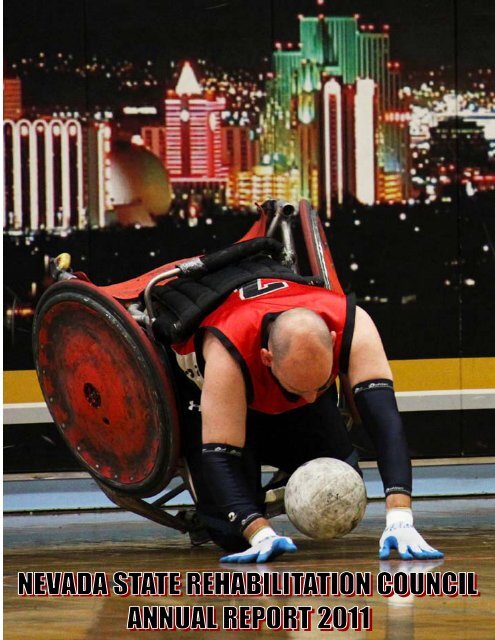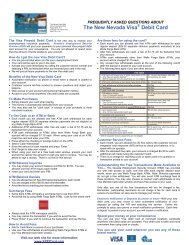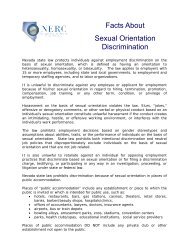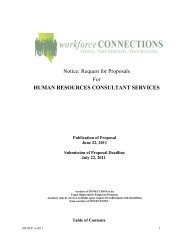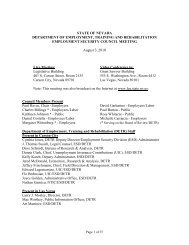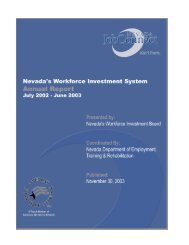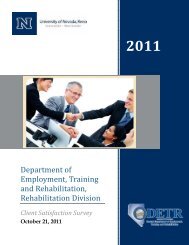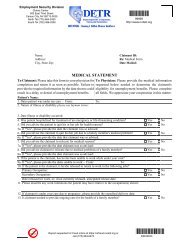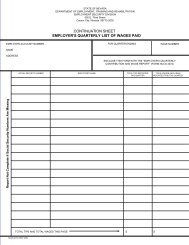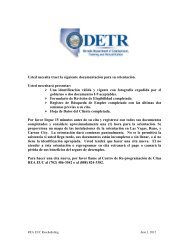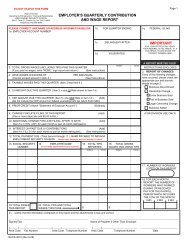Nevada Department of Employment, Training and Rehabilitation
Nevada Department of Employment, Training and Rehabilitation
Nevada Department of Employment, Training and Rehabilitation
- No tags were found...
You also want an ePaper? Increase the reach of your titles
YUMPU automatically turns print PDFs into web optimized ePapers that Google loves.
PlaceArtworkHereL OG OT R A V E L
“The best <strong>of</strong> who we are” surfaces while we engage in what wetruly love about life. - Janet MillerAbout the Cover; Cover:Janet Miller, Vocational <strong>Rehabilitation</strong> Client, client, Visual visual engineer Engineer <strong>and</strong> founder Founder <strong>of</strong> <strong>of</strong> LifestylePhotographics, makes it it her mission to to capture her subject’s personal “moment in in time” thatdemonstrates passion, strength <strong>and</strong> ability.One <strong>of</strong> One Reno’s <strong>of</strong> Reno’s great great events events is the is Reno the Reno Rumble Rumble Wheelchair Wheelchair Rugby Rugby Tournament, Tournament, also alsoknown as as Murder murder Ball ball or Quad quad rugby. Rugby. In 1988, the United States Quad Rugby Association(USQRA) was formed to to help regulate <strong>and</strong> promote the sport on on both a national <strong>and</strong>international level. In In 1993, it it became an an <strong>of</strong>ficial sport recognized by by the the International StokeM<strong>and</strong>eville Wheelchair Sports Federation <strong>and</strong> in in the year 2000, was changed to to a a full-metalcontact sport.Since Since its introduction, its introduction, quad rugby Quad Rugby has grown has grown to become to become a truly a international truly international sport, with sport, teams withteams now competing now competing from around from around the globe. the globe. There There are more are more than than 45 organized forty-five teams organized in the teams Unitedinthe States United with States many with others many in others developmental in the developmental stage. In addition stage. In to addition the teams to the in the teams U.S., in there US, isthere estimated is estimated to be at to least be at 20 least international twenty international teams from teams as far from away as as far Australia. away as Without Australia question, inaddition quad rugby to those is the in fastest Canada. growing Without wheelchair question, sport quad in rugby the world is the today. fastest growing wheelchairsport in the world today.The cover features a photograph <strong>of</strong> an amazing athlete named David Mengyan, who lives inMichigan, The cover <strong>and</strong> traveled features to a Reno, photograph NV to <strong>of</strong> play an amazing the tournament athlete named on the David Sin City Mengyan, Skulls team who lives <strong>of</strong>in Las Michigan, Vegas, NV. <strong>and</strong> David traveled travels to Reno regularly to play to in South the tournament America to on teach the Sin this City sport Skulls to quadriplegics. team <strong>of</strong> LasVegas, He has NV. also David played travels on the regularly Gold Medal to South U.S. America Team at the to teach first Maximus this sport to Tournament quadriplegics. in Bogota, He hasalso Columbia. played on the Gold Metal U.S. Team at the 1 st Maximus Tournament in Bogota, Columbia.This This photograph photograph captures captures David David in his in “moment his “moment in time”. in time.” His image His image serves serves as testimony as testimony that wethat are we truly are truly limitless… limitless…Lifestyle PhotographicsJanet Miller, Visual EngineerP.O. Box 2653Reno, NV 89505775-384-1080www.lifestylephotographics.com2011 NSRC Annual Report Page 1
MISSION STATEMENTThe Mission <strong>of</strong> the <strong>Nevada</strong> State<strong>Rehabilitation</strong> Council (NSRC) isto help ensure the Vocational<strong>Rehabilitation</strong> Programs (Bureau <strong>of</strong>Vocational <strong>Rehabilitation</strong> <strong>and</strong>Bureau <strong>of</strong> Services to the Blind <strong>and</strong>Visually Impaired) are consumeroriented, consumer driven <strong>and</strong> thatthe programs' services <strong>and</strong>resources result in employmentoutcomes for <strong>Nevada</strong>ns withdisabilities.NSRC MEMBERSBrian PatchettCommunity <strong>Rehabilitation</strong> ProgramEaster Seals Southern <strong>Nevada</strong>Christine SyversonBusiness AdvocateCity <strong>of</strong> Sparks, Human ResourcesEdina JamborDeaf & Hard <strong>of</strong> HearingAdvocacy Resource CenterJack Mayes<strong>Nevada</strong> DisabilityAdvocacy Law CenterJane GrunerBusiness Advocate<strong>Department</strong> <strong>of</strong> Health <strong>and</strong> HumanServices, Sierra Regional CenterJennifer Kane<strong>Department</strong> <strong>of</strong> EducationIndividuals with Disabilities Education ActJimmy BegayNative American Section 121Vocational <strong>Rehabilitation</strong> ProgramKate OstiStatewide IndependentLiving ProgramKathy TreantsParent <strong>Training</strong> Information Center<strong>Nevada</strong> PEPKevin HullBusiness AdvocateMaureen ColeAdministratorDETR <strong>Rehabilitation</strong> DivisionRobin Hall-WalkerCouncil ChairClient Assistance Program, DirectorScott YoungsCouncil Vice ChairBusiness AdvocateUniversity <strong>of</strong> <strong>Nevada</strong>, Reno<strong>Nevada</strong> Center for Excellence in DisabilitiesSheena KaufmanVocational <strong>Rehabilitation</strong> CounselorSteve Chartr<strong>and</strong>Community <strong>Rehabilitation</strong> ProgramGoodwill <strong>of</strong> Southern <strong>Nevada</strong>The <strong>Nevada</strong> State <strong>Rehabilitation</strong>Council (NSRC) is a citizen advisorycouncil appointed by the Governorto provide guidance to the state’sVocational <strong>Rehabilitation</strong> (VR)Program. Its members help to shapepolicy, engage in strategic planning,<strong>and</strong> provide guidance to promoteincreased employment forindividuals with disabilities.2011 NSRC Annual Report Page 2
MessageMessagefromfromthetheAdministratorChairIt is my pleasure to present the 2011 Annual Report <strong>of</strong> the <strong>Nevada</strong> State <strong>Rehabilitation</strong>Council. I extend my sincerest appreciation <strong>and</strong> thanks to each <strong>of</strong> you for the work over thelast year. The lingering economic recession in our state <strong>and</strong> the nation has taken its toll onstate agencies’ ability to deliver services. Reduced state funding impacts Vocational<strong>Rehabilitation</strong>’s (VR) ability to access federal VR funds <strong>and</strong> <strong>of</strong> course, jobs are few <strong>and</strong> farbetween for all <strong>Nevada</strong>ns. Despite the difficulties, the Division believes the role <strong>of</strong> the publicVR system does not end when participants find a job. We must <strong>of</strong>fer opportunities to obtaintraining <strong>and</strong> education that may eventually result in higher quality employment outcomes whileparticipants earn money at an entry-level job.The Division has partnered with other agencies in statewide initiatives such as Silver StateWorks which promises to serve VR customers <strong>and</strong> businesses more effectively through sharedresources <strong>and</strong> a “no wrong door” philosophy. Service to transition students is a primary focus, as directed by the<strong>Nevada</strong> State <strong>Rehabilitation</strong> Council through the State Plan. We are confident that those efforts will produce long-termbenefits as more students move into training <strong>and</strong> post secondary education that lead to careers. The tireless work <strong>of</strong>the VR staff; the support <strong>and</strong> direction <strong>of</strong> the Council; partnerships with other state <strong>and</strong> local agencies; a renewedrelationship with the federal <strong>Rehabilitation</strong> Services Administration (RSA) <strong>and</strong> Region IX Technical Assistance &Continuing Education (TACE) group; <strong>and</strong> wide ranging collaborations with employers, vendors, advocates, <strong>and</strong>community groups combine to lend unity <strong>of</strong> purpose to the efforts <strong>of</strong> all toward the shared goals <strong>of</strong> greaterself-sufficiency <strong>and</strong> independence for <strong>Nevada</strong>ns with disabilities.This year’s Annual Report highlights many <strong>of</strong> the Division’s activities over the past year <strong>and</strong> updates the progresstoward our goals. The work <strong>of</strong> Vocational <strong>Rehabilitation</strong> has probably never been more challenging, but the <strong>Department</strong><strong>of</strong> <strong>Employment</strong>, <strong>Training</strong> <strong>and</strong> <strong>Rehabilitation</strong> (DETR) <strong>and</strong> the <strong>Rehabilitation</strong> Division are committed to finding ways tomeet <strong>and</strong> overcome obstacles <strong>and</strong> barriers during the coming year. With the continued involvement <strong>of</strong> partners <strong>and</strong>stakeholders, I am confident <strong>of</strong> our success.Thank you! It is my pleasure to present the 2011 Annual Report <strong>of</strong> the <strong>Nevada</strong> State <strong>Rehabilitation</strong> Council. I extend my sincerest appreciation <strong>and</strong>thanks to each <strong>of</strong> you for the work <strong>of</strong> the last year. The lingering economic recession in our state <strong>and</strong> the nation has taken its toll on stateMaureenagencies’ abilityColeto deliver services. Reduced state funding impacts Vocational <strong>Rehabilitation</strong>’s ability to access federal VR funds <strong>and</strong> <strong>of</strong> course,Message jobs are few <strong>and</strong> from far between the Chair for all <strong>Nevada</strong>ns. Despite the difficulties, the Division believes the role <strong>of</strong> the public VR system does not end whenparticipants find a job. We must <strong>of</strong>fer opportunities to obtain training <strong>and</strong> education that may eventually result in higher quality employmentoutcomes while participants earn In money communities at an entry across level job. the country <strong>and</strong> especially here in <strong>Nevada</strong>, financial woe creates theThe Division has partneredneed forwithservicesother agenciesto manyinpopulationsstatewide initiatives<strong>of</strong> people.such as SilverWhileStateunemploymentWorks which promisesnationally,to serveis aroundVR8.3%for persons without disabilities it hovers around 13.2% for persons with disabilities.customers <strong>and</strong> businesses more effectively through shared resources <strong>and</strong> a “no wrong door” philosophy. Service to transition students is aIn casework, vocational success occurs by diligently identifying <strong>and</strong> providing resources forprimary focus, as directed by the <strong>Nevada</strong> State <strong>Rehabilitation</strong> Council through the State Plan. We are confident that those efforts will producethe effective removal <strong>of</strong> barriers hindering vocational success. We applaud the diligent efforts <strong>of</strong>long-term benefits as more studentsagencymovestaffintotaskedtrainingwith<strong>and</strong><strong>and</strong>postmeetingsecondarytheeducationchallenge.that lead to careers. The tireless work <strong>of</strong> the VR staff; thesupport <strong>and</strong> direction <strong>of</strong> the Council; We must partnerships continually with other educate state <strong>and</strong> ourselves local agencies; on what a renewed persons relationship with disabilities with the federal CAN <strong>Rehabilitation</strong> do as opposedServices Administration RSA) to <strong>and</strong> what Region they IX CAN Technical NOT Assistance do. Agency & Continuing staff provides Education information (TACE) group; via <strong>and</strong> community wide ranging outreach collaborations <strong>and</strong> withemployers, vendors, advocates, facilitates <strong>and</strong> community successful groups closure combine for to clients. lend unity We <strong>of</strong> purpose applaud to the their efforts efforts. <strong>of</strong> all toward the shared goals <strong>of</strong> greaterself-sufficiency <strong>and</strong> independence Still, for <strong>Nevada</strong>ns more can with be disabilities. done to create a stronger economic base for those desiring to achieveThis year’s annual success. report highlights Employers many <strong>of</strong> with the Division’s jobs to fill, activities we can over help the past you year fill <strong>and</strong> those updates positions. the progress Mentors toward with our skills goals. The toshare, work <strong>of</strong> call Vocational us; we <strong>Rehabilitation</strong> can match has you probably with mentees never been needful more challenging, <strong>of</strong> your expertise. but the <strong>Department</strong> Business <strong>of</strong> <strong>Employment</strong> owners willing <strong>Training</strong> to train, <strong>and</strong> <strong>Rehabilitation</strong> we havepeople <strong>and</strong> the <strong>Rehabilitation</strong> eager to learn Division vocationally are committed relevant to finding skills ways leading to meet to <strong>and</strong> successful overcome employment.obstacles <strong>and</strong> barriers during the coming year. With theYou are needed continued now more involvement than ever. <strong>of</strong> partners Get involved. <strong>and</strong> stakeholders, Together I am confident we can accomplish <strong>of</strong> our success. wonderful things. Make a differencetoday, for our future.Thank you!Sincerely,Robin Hall-WalkerMaureen Cole2011 NSRC Annual Report Page 3
STRATEGIC GOALSThe NSRC State Plan Committee revised the goals with correspondingstrategies <strong>and</strong> measurable indicators to align them with the recommendations <strong>and</strong>information revealed through the Comprehensive Statewide Needs Assessment, theCustomer Satisfaction Survey <strong>and</strong> sentiments expressed in NSRC meetings.The Comprehensive Statewide Needs Assessment is conducted every three years.During the Spring <strong>of</strong> 2007, the Bureau <strong>of</strong> Vocational <strong>Rehabilitation</strong> (BVR), inconjunction with the <strong>Nevada</strong> State <strong>Rehabilitation</strong> Council (NSRC) entered into acontract with the San Diego State University (SDSU) Interwork Institute to performa Statewide Needs Assessment.The Needs Assessment was comprised <strong>of</strong> focus groups consisting <strong>of</strong> current<strong>and</strong> past program participants, program services staff, vocational counselors, serviceproviders, advocacy groups <strong>and</strong> other programs <strong>and</strong> agencies that interact with theBVR’s vocational rehabilitation programs.A thorough analysis <strong>of</strong> the BVR’s program electronic case file data wasconducted as part <strong>of</strong> the Needs Assessment in order to determine trends <strong>and</strong>recommendations.A comparative analysis was also performed to reflect <strong>Nevada</strong>’s demographicsagainst states with similar size <strong>and</strong> population (Colorado, Arizona, Idaho, Wyoming,<strong>and</strong> New Mexico), as well as national trends. The Needs Assessment prompted theBVR <strong>and</strong> NSRC to develop a Strategic Plan focused on four major areas thatindicated potential unserved <strong>and</strong> underserved populations.Annual Customer Satisfaction Survey: The review <strong>and</strong> analysis <strong>of</strong> consumersatisfaction described in Section 105(c)(4) <strong>of</strong> the <strong>Rehabilitation</strong> Act <strong>and</strong> 34 CFR361.17(h)(4), was conducted by the University <strong>of</strong> <strong>Nevada</strong>, Reno (UNR), Center forResearch Design <strong>and</strong> Analysis <strong>and</strong> <strong>Nevada</strong> Center for Health Statistics <strong>and</strong>Informatics.Three consumer satisfaction survey instruments were utilized: the generalparticipant, transition student, <strong>and</strong> older individuals who are blind (OIB). The threesurvey instruments captured general vocational rehabilitation <strong>and</strong> transition studentconsumer satisfaction through a mixed-mode telephone <strong>and</strong> web-based survey. TheOIB survey was conducted via large font text as requested by OIB participants.The BVR <strong>and</strong> NSRC jointly requested UNR to begin a multiple year,longitudinal study <strong>of</strong> Consumer Satisfaction Survey results in order to determine ifsignificant statistical trends develop.The Federal Fiscal Year (FFY) 2011 State Plan Goals <strong>and</strong> progression towardachievement are:2011 NSRC Annual Report Page 4
GOAL #1Emphasize the employment potential <strong>of</strong> students with disabilities, <strong>and</strong> improve transitionfrom school to work <strong>and</strong> school to post-secondary education.Indicators:• Increase enrollment by transition students in the Program Services Division. The Division's performanceregarding increased enrollment in FFY 2011 will equal or exceed FFY 2010 performance levels.40003500300025002000150010005000All ParticipantApplicationsTransition StudentsFFY 201018%StudentsFFY 201120%Students• Increase competitive employment outcomes for transition students. The Division's performanceregarding increased competitive employment outcomes in FFY 2011 will equal or exceed FFY 2010preformance levels.7006005004003002001000All Student ClosuresStudents ClosedRehabilitatedFFY 201022%StudentsFFY 201122%Students• Increase post-secondary educational services for transition students. The Division's performanceregarding increased post-secondary educational services in FFY 2011 will equal or exceed FFY 2010preformance levels.8007006005004003002001000Students WithAuthorizationsStudents WithPost-SecondaryEducationFFY 201015%StudentsFFY 201116%Students2011 NSRC Annual Report Page 5
GOAL #2 GOAL #3Extend outreach efforts toward diversepopulations, specifically, eligible individualswith autism, developmental, cognitive <strong>and</strong>mental health disabilities.Indicators:• Increase enrollment by eligible individuals withautism, developmental, cognitive <strong>and</strong> mental healthdisabilities. The Division's performance to increaseenrollment by eligible individuals with autism <strong>and</strong>mental health disabilities in FFY 2011 will equal orexceed FFY 2010 performance levels.Extend outreach efforts toward ethnicallydiverse populations, specifically minoritypopulations with disabilities representedin <strong>Nevada</strong>’s workforce.Indicators:• Increase enrollment by minority populationsrepresentative <strong>of</strong> <strong>Nevada</strong>'s minority workforce.The Division's performance regarding increasedenrollment by minority populations in FFY 2011 willequal or exceed FFY 2010 performance levels.40003000200010000Closed Clients Participants WithMental HealthDisabilitiesFFY 201059% w ithDisabilityFFY 201159% w ithDisability40003000200010000Closed ClientsNon-White(MinorityClosures)FFY 201039%MinoritiesFFY 201138%Minorities16001400120010008006004002000DevelopmentalDisabilitiesCognitiveDisabilitiesAll Other MentalHealthDisabilitiesFFY 2010FFY 2011706050403020100Autism as Source / Cause <strong>of</strong>DisabilityFFY 2010FFY 20112011 NSRC Annual Report Page 6
GOAL #4 GOAL #5Work together <strong>and</strong> share resources withstate, private, non-pr<strong>of</strong>it agencies toleverage resources <strong>and</strong> coordinate benefitopportunities in order to maximize theoverall employment outcomes.Indicators:• The Division's performance regarding thenumbers <strong>of</strong> individuals rehabilitated who achievecompetitive employment in FFY 2011 will equal orexceed FFY 2010 performance levels.Emphasize the employment potential <strong>of</strong>applicants <strong>and</strong> eligible persons receivingservices <strong>and</strong> supported employment.Indicators:• Increase the number <strong>of</strong> supported employmentconsumers that close successfully, earning at leastthe federal minimum wage. The Division'sperformance regarding an increase in the number <strong>of</strong>supported employment consumers that closesuccessfully in FFY 2011 will equal or exceed FFY 2010performance levels.40003000200010000ClientsClosedClosed Closed OtherRehabilitatedFFY 201024% ClosedRehab.FFY 201126% ClosedRehab.40003000200010000Closed ClientsSupported<strong>Employment</strong>ClientsFFY 20103% S/EFFY 20112% S/E120110100908070Closed Rehab. With A/TClosed Other With A/TFFY 2010FFY 2011150100500Supported <strong>Employment</strong>Closed RehabilitatedSupported <strong>Employment</strong>Closed OtherFFY 2010123 TotalS/E ClientsFFY 201182 TotalS/E Clients2011 NSRC Annual Report Page 7
2011 NSRC Annual Report Page 8Primary Disabilities <strong>of</strong> Those Who Went to WorkMental Impairments45%Visual Impairments14%Hearing Impairments14%Physical/Orthopedic27%The Average Hourly Earnings for Competitive <strong>Employment</strong> Outcomes Statewide is $11.53.Health Insurance Breakdown by Closures23%28%23%17%9%PrivateInsurance<strong>Employment</strong>PrivateInsuranceOtherMedicaidMedicarePublicInsuranceGender Breakdown by ClosuresEthnicity Breakdown by ClosuresFemale44%White67%Asian2%Male56%Hawaiian/PacificIsl<strong>and</strong>er1%Black/AfricanAmerican16%Hispanic11%AmericanIndian3%
Job RelatedServices15%Services Provided Directly by State Agency / VR Funds<strong>Training</strong>4%Rehab TechnologyServices7%Diagnosis &Treatment2%Assessment25%Counseling & Guidance43%Other Services3%Other Services include: occupational licenses, tools & equipment, initial stock & supplies. Medical care for acute conditions arising duringrehabilitation <strong>and</strong> constituting a barrier to achievement <strong>of</strong> an employment outcome is also included in this category.Total number <strong>of</strong> individuals receiving servicesTotal number <strong>of</strong> new applicantsTotal number closed with employment outcomesTotal number that were closed with supported employment outcomes6,4273,78594740Sources <strong>of</strong> Revenue (Federal Fiscal Year 2011)State Funds$3,587,224Federal Funds$18,893,787Federal Funds include those received in FFY 11 through the American Recovery <strong>and</strong> Reinvestment Act (ARRA)Average Cost Per Closure with an<strong>Employment</strong> Outcome $3,272Average Cost Per Closurewithout an <strong>Employment</strong> Outcome(after receiving services)$2,8472011 NSRC Annual Report Page 9
2011 HIGHLIGHTSRSA Commissioner Visits <strong>Nevada</strong>In February 2011, <strong>Rehabilitation</strong> Services Administration (RSA)Commissioner, Lynnae Ruttledge gave the keynote address in Las Vegas, <strong>Nevada</strong>at the Sagebrush Conference for the R<strong>and</strong>olph Sheppard Vendors <strong>of</strong> America.At the <strong>Department</strong> <strong>of</strong> <strong>Employment</strong>, <strong>Training</strong> <strong>and</strong> <strong>Rehabilitation</strong>’s invitation,Commissioner Ruttledgethen traveled to Reno<strong>Nevada</strong> <strong>and</strong> met several<strong>Nevada</strong> State <strong>Rehabilitation</strong> Council members, representatives <strong>of</strong>non-pr<strong>of</strong>its <strong>and</strong> community training centers as well as <strong>Rehabilitation</strong>Division staff.A lively conversation with good questions from the attendeeswas followed by a luncheon <strong>and</strong> then a tour to show theCommissioner a JobConnect <strong>of</strong>fice in Reno, a <strong>Rehabilitation</strong> <strong>of</strong>ficelocated on Corporate Blvd. in Reno, <strong>and</strong> the Blind Enterprises <strong>of</strong><strong>Nevada</strong> site at the Washoe County complex.Vocational <strong>Rehabilitation</strong> Staff SpotlightSouthern District Manager, Sylvia Milburn“Several years ago I read a book by Jim Collins called, From Good toGreat. This book changed my life. I think we settle for being good butit’s ok to strive for greatness. It takes a different kind <strong>of</strong> skill set tothink that way. I have been the District Manager for a short time <strong>and</strong> Iam really enjoying this position because I am in a position to learn a lot<strong>of</strong> things <strong>and</strong> I can use my problem solving skills.”Sylvia Milburn was born <strong>and</strong> raised in Opelousas, Louisiana. She came to <strong>Nevada</strong> in 1986 shortly aftergraduating from college. She has a Master's in Special Education <strong>and</strong> a second Master’s Degree in <strong>Rehabilitation</strong>Counseling. She also completed the Post <strong>Employment</strong> <strong>Training</strong>: <strong>Rehabilitation</strong> Administration (PET-RA) through SanDiego State University. She joined the <strong>Rehabilitation</strong> team in December 1991. Throughout her tenure with the<strong>Rehabilitation</strong> Division, she has worked as a <strong>Rehabilitation</strong> Counselor II, III <strong>and</strong> a <strong>Rehabilitation</strong> Supervisor. In 2002, shebecame a certified rehabilitation counselor.While working as a counselor, Sylvia served the rural communities, opened the first one-stop <strong>and</strong> was instrumentalin assisting the Las Vegas Paiutes with getting their first 121 Tribal Vocational <strong>Rehabilitation</strong> Project. She was a committeemember <strong>of</strong> Work Enhancement <strong>Employment</strong> Team (WEET). She was part <strong>of</strong> a newly founded team – The <strong>Employment</strong>Team. This was a team that was designed to assist job-ready clients with obtaining employment. She was promoted to<strong>Rehabilitation</strong> Supervisor where she supervised Transition Services <strong>and</strong> Bureau <strong>of</strong> Services to the Blind <strong>and</strong> VisuallyImpaired. She was instrumental in starting CRAVE – summer youth program at UNLV. Her hope was to increasetransition student enrollment in college. She worked with Clark County School District to develop Project Search, aprogram designed to give transition students on-the-job-training. She was also a committee member <strong>of</strong> the <strong>Nevada</strong>Transition Advisory Committee (N-TAC). While working with Services to the Blind <strong>and</strong> Visually Impaired, she served as acommittee member for the Vision Forum, a yearly event for blind <strong>and</strong> visually impaired clients to learn about resources inthe community. In addition, Sylvia is currently a member <strong>of</strong> the State <strong>of</strong> <strong>Nevada</strong> Council for the Blind.2011 NSRC Annual Report Page 10
COLLABORATIONS♦ For several years, the Bureau <strong>of</strong> Vocational <strong>Rehabilitation</strong> (BVR), in collaboration with the University <strong>of</strong> <strong>Nevada</strong> Las Vegas(UNLV), Accessing Services <strong>and</strong> Programs for Individuals With Disabilities (ASAP Services), AmeriCorps Volunteers InService To America (VISTA) <strong>and</strong> the Clark County School District (CCSD), provides a week long College <strong>and</strong> <strong>Employment</strong>Preparatory Summer Camp for 10 to 20 11th <strong>and</strong> 12th grade transition students at the UNLV campus. During the Careers,Recreation <strong>and</strong> Vocational Education (CRAVE) Summer Camp BVR presents the CCSD’s Youth Educational Success (YES)Program to the studentsMAKINGinterested in going to collegeA<strong>and</strong> providesDIFFERENCEjob seeking <strong>and</strong> readiness training to students interestedin employment. The program’s short-term goal is to help participants break down barriers to consider college as a choice withthe long-term goal <strong>of</strong> increasing the percentage <strong>of</strong> students going to college. BVR, in collaboration with Rebuilding All GoalsEfficiently (RAGE), <strong>and</strong> the University <strong>of</strong> <strong>Nevada</strong>, Reno (UNR) Center for Excellence in Disabilities (NCED) held the thirdannual CRAVE Summer Camp in June 2011. For the first time, the program was extended to students in northern <strong>and</strong> rural<strong>Nevada</strong> with the help <strong>of</strong> funds made available through a new partnership with the <strong>Nevada</strong> <strong>Department</strong> <strong>of</strong> Education (NDE).♦ In June 2011, BVR entered into an inter-local agreement with UNR/NCED <strong>and</strong> Sierra Regional Center (SRC). The intentis to identify those individuals at SRC who are best prepared for competitive employment. Collaboratively, a team <strong>of</strong> the SRCcase manager, the BVR counselor <strong>and</strong> the NCED job developer will work to develop customized employment opportunities.Service highlights include unique, interest-based workplace assessment, a video resume, job carving <strong>and</strong> identification <strong>of</strong> longterm supports. These services will be more individualized <strong>and</strong> intensive than the traditional model.♦ Bureau <strong>of</strong> Services to the Blind <strong>and</strong> Visually Impaired (BSBVI) collaborated with the CCSD in the assessment <strong>of</strong> assistivetechnologies specific to the needs <strong>of</strong> visually impaired students. BSBVI staff participate in transition workshops to provide group<strong>and</strong> individual training <strong>of</strong> students with visual impairments. BSBVI staff provides ongoing assistive technology trainingstatewide for special education teachers so they can provide this training to students who are blind or visually impaired.♦ BVR <strong>and</strong> the NDE, Office <strong>of</strong> Special Education, Elementary <strong>and</strong> Secondary Education <strong>and</strong> School Improvement Programshave a cooperative agreement, which contains provisions for the joint training <strong>of</strong> VR staff <strong>and</strong> special education personnel.♦ BVR is currently working with the school districts to provide for joint in-service training coordinated by local BVR <strong>of</strong>fices.The local <strong>of</strong>fices work with special education departments <strong>and</strong> technical <strong>and</strong> career education programs for the establishment<strong>of</strong> pre-vocational coordinated activities. Future plans include an increased effort for outreach to all students with disabilities,including students with disabilities who are not enrolled in special education.♦ Statewide, BVR <strong>and</strong> BSBVI staff attend transition team meetings with local schools <strong>and</strong> school districts to provide ongoingorientation <strong>and</strong> education regarding BVR services, as well as having co-located <strong>of</strong>fices with school district personnel in Washoe<strong>and</strong> Clark Counties.♦ BSBVI <strong>and</strong> BVR Southern District <strong>of</strong>fice staff attend bi-annual “Students Talking about the Real World” (STAR) conferenceswith Las Vegas area school district special education staff. STAR is a program that is designed to educate families, students <strong>and</strong>pr<strong>of</strong>essionals about transition services available in Clark County. Our transition counselors <strong>of</strong>fer BVR facility tours <strong>and</strong> provideorientation about our services. Students are given the opportunity to meet with agencies, vendors, <strong>and</strong> colleges to see whatservices are available to assist them in meeting their goals.♦ The BVR Administrator is a member <strong>of</strong> the Interagency Transition Advisory Board (ITAB). The Board provides information<strong>and</strong> research regarding issues relating to transition students in <strong>Nevada</strong>.♦ A BVR <strong>Rehabilitation</strong> Counselor is a member <strong>of</strong> the NDE’s <strong>Nevada</strong> Transition Advisory Committee (NTAC) Core Team.Members <strong>of</strong> the NTAC Core Team are experts in the field <strong>of</strong> transition <strong>and</strong> provide ongoing training <strong>and</strong> recommendationsaround best practice/compliance in transition services. The team’s mission is to implement a systematic approach to increasinggraduation rates <strong>and</strong> improving postsecondary outcomes for students with disabilities through a greater focus on postsecondarypreparation. The team has created the first ever <strong>Nevada</strong> Statewide Transition Network, developed in the <strong>Nevada</strong> StudentLeadership Transition Summit (the 5th annual event took place in November, 2011) <strong>and</strong> recently presented at the 16thInternational Division on Career Development <strong>and</strong> Transition (DCDT) Conference in Kansas City, Missouri.2011 NSRC Annual Report Page 11
MAKING A DIFFERENCEClaude Church <strong>and</strong> his wife scrambled to the nearest Emergency Room (ER) in Minden, <strong>Nevada</strong> after Claudewas jolted awake in the middle <strong>of</strong> the night gasping for air. He was disoriented <strong>and</strong> confused, <strong>and</strong> was seeing double. After avariety <strong>of</strong> tests <strong>and</strong> an endless battery <strong>of</strong> MRI’s, CAT scans <strong>and</strong> X-Rays, it was eventually revealed that Claude had experienceda strong trauma to the third cranial optic nerve as he slept. He was diagnosed in 2005.Several years later, Claude still suffered from double vision which led to a long relay <strong>of</strong> surgeries. He made every effort tocontinue to adjust to his changing vision. By the time he signed up for services at the Bureau <strong>of</strong> Services to the Blind <strong>and</strong> VisuallyImpaired (BSBVI), he was eager to get back to being a productive part <strong>of</strong> the work force, even though he was still set toundergo a few more medical interventions before his condition would stabilize.During this time, he <strong>and</strong> his wife would occasionally stop by a local c<strong>of</strong>fee roaster that they had read about to buy freshroasted c<strong>of</strong>fee. Claude had, in the past, worked for some major c<strong>of</strong>fee roasters in the packaging departments, <strong>and</strong> he <strong>and</strong> hiswife appreciated the aroma <strong>and</strong> taste <strong>of</strong> quality c<strong>of</strong>fee. Over the years, the staff at Alpen Sierra grew to know Claude <strong>and</strong>would chat with him during his visits.The staff at BSBVI worked with Claude as he took stock <strong>of</strong> his work history <strong>and</strong> helped him to better appreciate how hisown unique skills, interests <strong>and</strong> preferences could apply to his next line <strong>of</strong> work. They also provided counseling <strong>and</strong> guidance,discussing his strengths, as he built up his self-esteem <strong>and</strong> again developed confidence in his abilities. While compiling his workhistory for his resume, they noted that he had worked as a machine repairman at several firms. They then helped him to developan introduction “pitch” which would sum up his contributions as an employee.With all this preparation, Claude set out on his job search. He plowed the internet <strong>and</strong> made phone calls. Most importantly,he got in his car <strong>and</strong> drove to local industrial parks <strong>and</strong> went door to door. He would confidently enter the business <strong>and</strong>pr<strong>of</strong>essionally introduce himself to any staff member that was there, learning more about their business. In this process, he wasalso able to discuss the On the Job <strong>Training</strong> (OJT) program.In one <strong>of</strong> the industrial parks which Claude prospected through was the local c<strong>of</strong>fee roaster he <strong>and</strong> his wife had beenvisiting over the years. He met with the founder <strong>and</strong> owner <strong>of</strong> AlpenSierra C<strong>of</strong>fee Roasters, Christian Waskiewicz, <strong>and</strong> they discussedthe needs <strong>of</strong> the business.During their talk, Claude mentioned his experience with machine repair,working with c<strong>of</strong>fee roasters; he knew c<strong>of</strong>fee <strong>and</strong> how to talk the language<strong>of</strong> the industry. Mr. Waskiewicz told him that he did, indeed, have a needfor a person to service his c<strong>of</strong>fee brewing equipment. Claude hadexperience <strong>and</strong> it was a perfect match. “I guess I don’t need to interviewthe other 62 people!” Upon hearing those words, Claude knew that hehad finally l<strong>and</strong>ed the job that he had worked so hard for. It had been sixlong years since that night that his journey had begun.Mr. Waskiewicz appreciated the value <strong>of</strong> BSBVI’s OJT program, <strong>and</strong>was pleased to participate. By being proactive in his job search <strong>and</strong> buildingrelationships, Claude happened to have the right conversation, with the rightperson, at the right time. Alpen Sierra now has the employee that theyneeded, <strong>and</strong> Claude Church has the exact job that suits his skills,experience <strong>and</strong> interests.(Left:Christian Waskiewicz; Right: Claude Church)2011 NSRC Annual Report Page 12
MAKING A DIFFERENCEAllen Seals was diagnosed with paraplegia in 1979. In 2002, Allen was hired at Sparks High School asa special education teacher <strong>and</strong> football coach. He hada partial foot amputation in July, 2010 which resultedin the inability to balance properly. This led to newchallenges. Allen found it difficult to transfer from hischair into his vehicle, <strong>and</strong> he had difficulty movingaround in the bathroom.Allen applied for Bureau <strong>of</strong> Vocational <strong>Rehabilitation</strong>(BVR) services on August 4, 2010. After meeting witha <strong>Rehabilitation</strong> Counselor it was determined that Allenwould need to have his van modified so that he coulddrive his power wheelchair into the van <strong>and</strong> drive fromthe wheelchair.His bathroom also needed modifications. When Allenhad applied for services, a physical therapist was sentto inspect his bathroom <strong>and</strong> found that the set upinvolved a hole in the wall which Allen would drive his wheelchair through, into a closet <strong>and</strong> then into the bathroom. Itwas a very unsafe situation <strong>and</strong> Allen reported that he had fallen several times.The modifications involved the removal<strong>of</strong> a step into the bathroom, which then allowed Allen to drive his wheelchair into the shower stall directly. His toilet wasrepositioned to allow greater ease <strong>of</strong> transfer <strong>and</strong> the hole in the wall was covered <strong>and</strong> tiled.The BVR services improved Allen’s daily living abilities <strong>and</strong> assisted him in retaining his employment. He is now ableto take a shower everyday, unassisted, prior to driving to work.Marnie Macrillo was diagnosed with a brain tumor at the age <strong>of</strong> 27. She had surgery to remove thetumor followed by radiation treatments. The surgery <strong>and</strong> treatments were successful.One morning, 11 years after the surgery, Marnie awoke to find she had completely lost her hearing. The medicalcommunity indicates the hearing loss was a direct result <strong>of</strong> the radiation treatment.Marnie applied for Bureau <strong>of</strong> Vocational <strong>Rehabilitation</strong> (BVR) services as she was now at risk <strong>of</strong> losing heremployment as a Pilates Instructor.After meeting with a <strong>Rehabilitation</strong> Counselor, an assistive technology assessment was requested. Easter Seals <strong>of</strong>Southern <strong>Nevada</strong> completed the assessment <strong>and</strong> made recommendations to enable Marnie to use her telephone <strong>and</strong>computer. As a result <strong>of</strong> the recommendations BVR was able to assist Marnie in obtaining hearing aids <strong>and</strong> otherassistive technology devices.Marnie has been able to maintain her employment <strong>and</strong> uses her hearing aids, telephone <strong>and</strong> computer to performthe essential duties <strong>of</strong> her job as well as daily life activities.“Between the hearing aids <strong>and</strong> the phone I feel so much more connected to the movement <strong>of</strong> theday, the world. What would I have ever done without technology? It has made it a lot easier to dealwith my hearing loss."2011 NSRC Annual Report Page 13
MAKING A DIFFERENCETurner N. Thompson was born in 1983 <strong>and</strong> was fortunate to be alive after a very difficult labor thatalmost took his <strong>and</strong> his mother’s life. At the age <strong>of</strong> 4, he was diagnosed as having gross motor skill delay, speechimpediment <strong>and</strong> a severe learning disability. A medical pr<strong>of</strong>essional bluntly described him as borderline mentallyretarded, <strong>and</strong> told his mother that there wasn’t much hope for his mental, physical or social development beyond theborderline. Pr<strong>of</strong>essional after pr<strong>of</strong>essional, therapist after therapist, <strong>and</strong> teacher after teacher all agreed with thediagnosis. In 1989, before Turner had completed his firstunsuccessful year <strong>of</strong> kindergarten, his mother made one <strong>of</strong> the mostheartfelt <strong>and</strong> significant decisions <strong>of</strong> her life, to end her successful14-year military career. From that day forward she devoted the next22 years in an effort to take him beyond the borderline.Always emphasizing the importance <strong>of</strong> education, his motherworked diligently along with his special education teachers. In May2004, Turner left high school with a certificate <strong>of</strong> completion at theage <strong>of</strong> 21. The few who thought he would never accomplish muchwould be fascinated to know he has learned to read <strong>and</strong> write on athird grade level <strong>and</strong> underst<strong>and</strong> basic Algebra <strong>and</strong> math. He latertook up amateur boxing which helped develop his coordination, corestrength, <strong>and</strong> stamina. He even earned a couple <strong>of</strong> first place trophiesfor boxing matches. Still in his early 20s, Turner yearned to accomplishmore. Having spent a lot <strong>of</strong> time in the kitchen with his mother learninghow to cook different recipes <strong>and</strong> being allowed to participate in ahome economics class in high school, he soon developed the desireto become a chef, but was concerned about his educational challengesat any institution <strong>of</strong> higher learning. During 2008 <strong>and</strong> 2009, Turnertraveled <strong>and</strong> trained with a few notable amateur <strong>and</strong> pr<strong>of</strong>essional boxing coaches across the country. In early 2009, hisamateur boxing aspirations <strong>and</strong> training brought him to Las Vegas, NV. After being in the area several weeks, hismother decided to stay in Las Vegas. After they settled into a home, she scheduled an appointment for him with theBureau <strong>of</strong> Vocational <strong>Rehabilitation</strong>. There they met Ofelia Gentscheff, M.A., MRC, Certified <strong>Rehabilitation</strong>Counselor. After Turner entered the Vocational <strong>Rehabilitation</strong> (VR) program, Turner was provided with the counselingservices necessary to devise an Individualized Plan <strong>of</strong> <strong>Employment</strong> (IPE) allowing him to effectively train in the pr<strong>of</strong>ession<strong>of</strong> his choice, as well as provide him with the additional resources necessarry to assist with his success. Thisincluded the opportunity to attend the Las Vegas Culinary <strong>Training</strong> Academy (Academy) to become apr<strong>of</strong>essional cook.Turners's Orientation Supervisor <strong>and</strong> <strong>Employment</strong> Services Specialist, Sheila Smalling, was advised <strong>of</strong> his learningdisability <strong>and</strong> shared that information with other Academy Administrators. It was recommended that he attend theSteward Program <strong>and</strong>, if, upon successful completion <strong>of</strong> that program he would be allowed to enter the Pr<strong>of</strong>essionalCook Program. A few were apprehensive <strong>of</strong> Turner's ability to complete the requirements <strong>of</strong> such a dem<strong>and</strong>ingcourse, even with the additional resources provided by VR. Having become accustomed to people doubting hisabilities, only added fuel to Turner's desire to succeed. After being accepted <strong>and</strong> enrolled for training at the Academy,he was provided with Regional Transit Authority Bus Passes by VR, <strong>and</strong> in July 2009 he embarked upon his new lifeadventure diligently <strong>and</strong> happily.2011 NSRC Annual Report Page 14
MAKING A DIFFERENCEWith the steadfast encouragement <strong>and</strong> support <strong>of</strong> Mrs. Gentscheff from VR, Ms. Smalling at the Academy, <strong>and</strong> hismother at home, Turner completed the Academy's Steward program in September 2009, where he was certified onhow to clean <strong>and</strong> maintain kitchen areas <strong>and</strong> equipment, including deep fryers, broilers, grills, stoves <strong>and</strong> conventionalovens; washing dishes; h<strong>and</strong>ling chemicals properly, as well as assisting with banquet preparation <strong>and</strong> clean-up. Hebecame knowledgeable in basic cooking principles <strong>and</strong> mid-level skills for the fry cook <strong>and</strong> pantry cook <strong>and</strong> was ableto achieve performance <strong>of</strong> all entry level duties as well as more advanced skills such as preparing sauces, soups <strong>and</strong>stocks.The Associate Director <strong>of</strong> Instruction <strong>and</strong> others at the Academy began to take notice <strong>of</strong> Turner's determination<strong>and</strong> potential with the necessary resources in place, allowing him to start the Pr<strong>of</strong>essional Cook Program in November2009. He completed the program <strong>and</strong> graduated on March 5, 2010, where he was certified as having gainedknowledge <strong>of</strong> kitchen equipment, Serve Safe, line mechanics, plate <strong>and</strong> food presentation, hot <strong>and</strong> cold foodproduction, assisting with banquet events <strong>and</strong> developing knife skills in the operations <strong>of</strong> a pr<strong>of</strong>essional kitchen.Turner secured employment as a steward as well as prep <strong>and</strong> fry cook at the Cadillac Ranch in Las Vegas, NV.Turner's pr<strong>of</strong>essional education is ongoing with a h<strong>and</strong>s-on approach. Cadillac Ranch General Manager, Mr. DonnieFrazier, states, "In the past year, Turner's exceptional attitude, desire to accept additional responibiitiescoupled with his customer friendly demeanor, dependability, eagerness to learn every facet <strong>of</strong> therestaurant business <strong>and</strong> work ethic have made him a valuable asset to our organization."Benjamin Dalin was born blind. At the age <strong>of</strong> 16 he became a Vocational <strong>Rehabilitation</strong> Client. Ben iscurrently in his third year at Great Basin College in Elko, NV where he is studying Social Sciences with an emphasis inHistory. In May, 2011 Ben told his counselor, Ron Pavelko, that he wanted to locate summer employment that alignedwith his interests. During the previous summer, Ben had worked at Papa Murphy’s Pizza, where he began by takingphone orders. After his supervisor saw his capabilities <strong>and</strong> potential, he wasmoved to a cashier position where he performed multiple assignments.After researching available opportunities, Ben’s counselor, Ron, found thatNortheastern <strong>Nevada</strong> Museum in Elko, NV had accepted students for summeremployment in the past. Ron immediately contacted the Museum Director, ClaudiaWines. An appointment was scheduled for Ron <strong>and</strong> Ben to meet with Ms. Wines<strong>and</strong> her coordinator, Toni Mendive.When Ron <strong>and</strong> Ben arrived at the Museum, Ron was really struggling tryingto figure out what tasks a blind transition student might be able to perform here.He was concerned that this might be a courtesy meeting. Toni <strong>and</strong> Ben hit it <strong>of</strong>fright away. About two minutes into the meeting, Toni looked at Ben <strong>and</strong> said “oralhistories.” One <strong>of</strong> the functions <strong>of</strong> the Museum was to seek out local persons whohave some responsibility in regards to the history <strong>of</strong> the local area. These historicalpersons would then need to be interviewed <strong>and</strong> the transcription would be recordedfor future use. Ben was the perfect fit for the Orator position. An excited DirectorWines asked him “when can you start?” Ben really enjoys the work that he isdoing. He feels it has a real benefit for the local community, <strong>and</strong> the Museum staffis extremely pleased with his pr<strong>of</strong>essionalism <strong>and</strong> advanced computer skills.“I am glad <strong>and</strong> appreciative<strong>of</strong> all the opportunities Ihave had. Disabilities do nothave to stop you fromreaching your goals.”2011 NSRC Annual Report Page 15
<strong>Rehabilitation</strong> DivisionBUREAU OF VOcAtiOnAl REhABilitAtiOn tiOn lOcAtiOnsVocational <strong>Rehabilitation</strong> (VR) <strong>and</strong> Bureau <strong>of</strong> Services to the Blind <strong>and</strong> Visually Impaired (BSBVI)Northern <strong>Nevada</strong> Locations1933 N. Carson Street 4001 S. Virginia StreetCarson City, NV 89701 (Carson) Reno, NV 89502 (Washoe)(775) 684-0400 TTY (775) 684-0360 (775) 834-19701325 Corporate Boulevard 1675 E. Prater Way, Suite103Reno, NV 89502 (Washoe)Sparks, NV 89434 (Washoe)(775) 823-8100 TTY (775) 688-1426 (775) 336-5400Rural <strong>Nevada</strong> Locations172 6th Street 1500 Avenue F, Suite 1Elko, NV 89801 (Elko)Ely, NV 89301 (White Pine)(775) 753-1931 (775) 289-1675475 W. Haskell Street, Suite 2 121 Industrial WayWinnemucca , NV 89445 (Humboldt) Fallon, NV 89406 (Churchill)(775) 623-6544 (775) 423-6568Southern <strong>Nevada</strong> Locations3016 W. Charleston Suite 200 3405 S. Maryl<strong>and</strong> ParkwayLas Vegas, NV 89102 (Clark)Las Vegas, NV 89169 (Clark)(702) 486-5230 TTY (702) 486-5217 (702) 486-01002827 Las Vegas Boulevard North 119 Water StreetNorth Las Vegas, NV 89030 (Clark) Henderson, NV 89015 (Clark)(702) 486-0200 (702) 486-0300 TTY (702) 486-68302011 NSRC Annual Report Page 16
2011 NSRC Annual Report Page 17
The <strong>Rehabilitation</strong> Division <strong>of</strong><strong>Department</strong> <strong>of</strong> <strong>Employment</strong>, <strong>Training</strong> <strong>and</strong> <strong>Rehabilitation</strong><strong>Rehabilitation</strong> Division<strong>Nevada</strong> State <strong>Rehabilitation</strong> Council1370 South Curry StreetCarson City, NV 89703-5147(775) 684-3200www.nvdetr.orgThe <strong>Rehabilitation</strong> Division’s vision is that <strong>of</strong> a barrier-free future where every individual in <strong>Nevada</strong> hasequal vocational <strong>and</strong> independent living opportunities.


